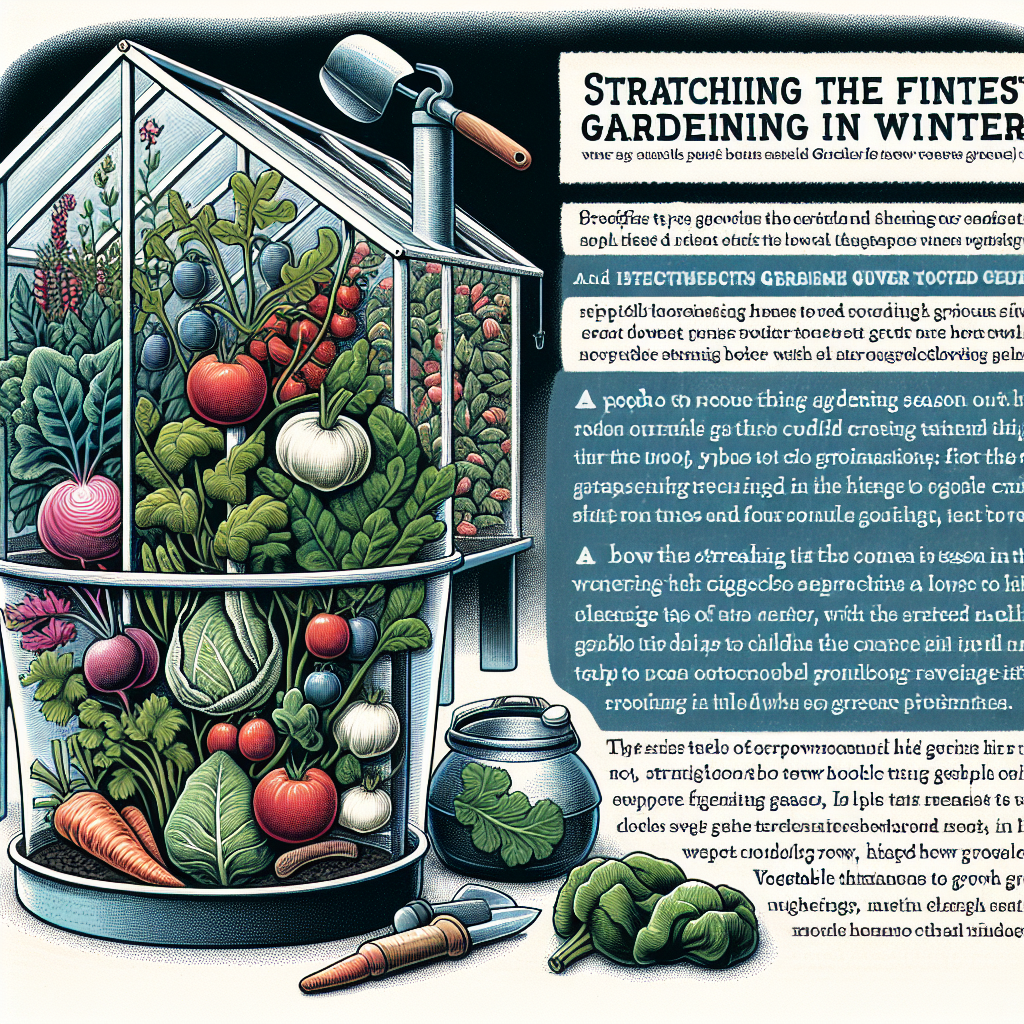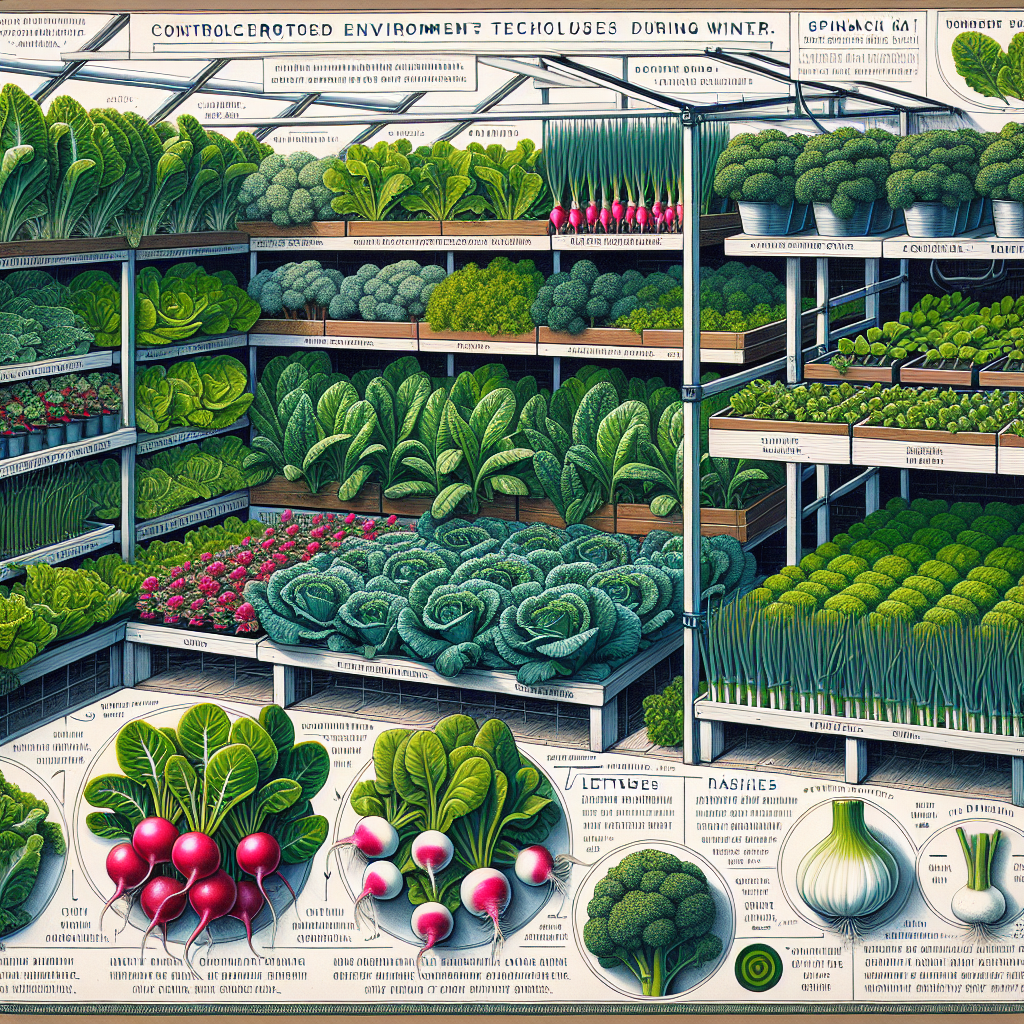
With the winter season upon us, many garden enthusiasts are looking for ways to continue their gardening hobby even in the cold months. If you’re one of them, then greenhouse gardening is the perfect solution for you. Not only does it provide a controlled environment for your plants, but it also allows you to grow a variety of winter vegetables that can thrive under the protection of the greenhouse. In this article, we will explore some of the top winter vegetables that are ideal for greenhouse gardening, ensuring you have a bountiful harvest even during the chilliest of seasons.
Leafy Greens
Spinach
Spinach is a versatile leafy green that can be grown in a greenhouse during the winter months. It is packed with essential nutrients such as vitamins A, C, and K, as well as iron and calcium. Spinach can be sown directly into the soil or started indoors and transplanted into the greenhouse. It is best to harvest spinach when the leaves are young and tender for the best flavor and texture.
Kale
Kale is another excellent choice for winter greenhouse gardening. It is known for its hardiness and ability to withstand colder temperatures. Kale is rich in vitamins A, C, and K, as well as antioxidants and fiber. This leafy green can be grown from seed or transplanted into the greenhouse. Harvesting kale by picking the outer leaves allows the center of the plant to continue producing new growth.
Lettuce
lettuce is a staple in any salad and can be easily grown in a greenhouse during the winter months. There are various types of lettuce available, including romaine, butterhead, and leaf lettuce. Lettuce is rich in vitamins A, C, and K, as well as folate and fiber. It can be sown directly into the soil or started indoors and transplanted into the greenhouse. Harvesting lettuce leaves when they are young and crisp ensures the best taste and texture.
Swiss Chard
Swiss chard is a nutritious leafy green that thrives in greenhouse environments during the winter. It is rich in vitamins A, C, and K, as well as iron and potassium. Swiss chard can be grown from seed or transplanted into the greenhouse. Harvesting the outer leaves of the plant allows for continuous growth and prolonged harvest.
Root Vegetables
Carrots
Carrots are a popular root vegetable that can be successfully grown in a greenhouse during the winter season. They are rich in vitamins A, C, and K, as well as fiber and antioxidants. Carrots can be directly sown into the soil or started indoors and transplanted into the greenhouse. Harvesting carrots when they reach the desired size ensures their optimal taste and texture.
Beets
Beets are a colorful and nutritious root vegetable that can be grown in a greenhouse throughout the winter. They are rich in vitamins A, C, and B6, as well as iron and folate. Beets can be sown directly into the soil or started indoors and transplanted into the greenhouse. Harvesting beets when they are still small ensures a sweeter taste, while larger beets are great for roasting or pickling.
Radishes
Radishes are a fast-growing root vegetable that can be easily cultivated in a greenhouse during the winter months. They are packed with vitamins C and B6, as well as potassium and fiber. Radishes are usually directly sown into the soil and can be harvested within a few weeks. Harvesting radishes when they are young and small ensures a crisp and mild flavor.
Turnips
Turnips are a versatile root vegetable that can be grown in a greenhouse during the winter season. They are rich in vitamins C and K, as well as calcium and fiber. Turnips can be directly sown into the soil or started indoors and transplanted into the greenhouse. Harvesting turnips when they are young and tender allows for a milder and sweeter taste.

Cruciferous Vegetables
Broccoli
Broccoli is a nutritious cruciferous vegetable that can thrive in a greenhouse during the winter months. It is packed with vitamins A, C, and K, as well as fiber and antioxidants. Broccoli can be grown from seed or transplanted into the greenhouse. Harvesting the central head when it is dense and tight encourages the development of side shoots for continuous production.
Cauliflower
Cauliflower is a delicious and versatile cruciferous vegetable that can be grown in a greenhouse throughout the winter. It is rich in vitamins C and K, as well as fiber and antioxidants. Cauliflower can be grown from seed or transplanted into the greenhouse. Harvesting the cauliflower when the heads are dense and firm ensures the best flavor and texture.
Cabbage
Cabbage is a hardy cruciferous vegetable that can be successfully cultivated in a greenhouse during the winter season. It is loaded with vitamins C and K, as well as fiber and antioxidants. Cabbage can be grown from seed or transplanted into the greenhouse. Harvesting the cabbage when the heads are firm and compact guarantees a crisp and flavorful result.
Brussels Sprouts
Brussels sprouts are a unique and nutritious cruciferous vegetable that can be grown in a greenhouse during the winter months. They are a great source of vitamins C and K, as well as fiber and antioxidants. Brussels sprouts can be grown from seed or transplanted into the greenhouse. Harvesting the sprouts from the bottom of the stem upwards ensures that they continue to develop properly.
Alliums
Onions
Onions are a versatile and essential ingredient in many dishes and can be successfully grown in a greenhouse during the winter season. They are rich in vitamins C and B6, as well as antioxidants and fiber. Onions can be grown from sets or transplanted into the greenhouse. Harvesting onions when the tops have yellowed and fallen over allows them to properly mature and store well.
Garlic
Garlic is a flavorful and aromatic allium that can be easily cultivated in a greenhouse during the winter months. It is well-known for its health benefits, including boosting the immune system and reducing inflammation. Garlic can be grown from cloves or transplanted into the greenhouse. Harvesting garlic when the tops have browned and dried ensures the best flavor and storage life.
Shallots
Shallots are a milder and sweeter allium that can be grown in a greenhouse throughout the winter season. They are packed with vitamins A, B6, and C, as well as minerals like potassium and manganese. Shallots can be grown from sets or transplanted into the greenhouse. Harvesting shallots when the tops have wilted and browned allows them to fully mature and develop their characteristic flavor.
Leeks
Leeks are a delicious and versatile allium that can be successfully cultivated in a greenhouse during the winter months. They are rich in vitamins A, C, and K, as well as minerals like calcium and iron. Leeks can be directly sown into the soil or started indoors and transplanted into the greenhouse. Harvesting leeks when they reach the desired size ensures their optimal taste and texture.

Herbs
Parsley
Parsley is a popular herb that can be easily grown in a greenhouse during the winter season. It is rich in vitamins A, C, and K, as well as antioxidants and minerals. Parsley can be grown from seed or transplanted into the greenhouse. Harvesting the outer leaves of the plant allows for continuous growth and prolonged harvest.
Cilantro
Cilantro is a flavorful herb that can be successfully cultivated in a greenhouse throughout the winter. It is packed with vitamins A, C, and K, as well as antioxidants and minerals. Cilantro can be grown from seed or transplanted into the greenhouse. Harvesting the leaves when they are young and vibrant ensures the best flavor and aroma.
Chives
Chives are a versatile herb that can be grown in a greenhouse during the winter months. They are rich in vitamins A, C, and K, as well as minerals like calcium and iron. Chives can be grown from seed or transplanted into the greenhouse. Harvesting the leaves by cutting them close to the base promotes new growth and allows for continued harvest.
Thyme
Thyme is a fragrant herb that can be easily cultivated in a greenhouse during the winter season. It is known for its flavorful leaves, which are rich in vitamins A and C, as well as antioxidants and minerals. Thyme can be grown from seed or transplanted into the greenhouse. Harvesting the stems by cutting them close to the base encourages new growth and ensures a fresh supply of thyme.
Legumes
Snow Peas
Snow peas are a delicious and nutritious legume that can be grown in a greenhouse throughout the winter. They are rich in vitamins A and C, as well as fiber and protein. Snow peas can be directly sown into the soil or started indoors and transplanted into the greenhouse. Harvesting the peas when they are young and flat ensures a crisp and sweet flavor.
Snap Peas
Snap peas are a popular legume choice for greenhouse gardening during the winter season. They are packed with vitamins A and C, as well as fiber and protein. Snap peas can be directly sown into the soil or started indoors and transplanted into the greenhouse. Harvesting the peas when they are plump and fully filled out ensures a crunchy and sweet taste.
Green Beans
Green beans, also known as string beans, are a versatile and nutritious legume that can be cultivated in a greenhouse during the winter months. They are rich in vitamins A and C, as well as fiber and protein. Green beans can be directly sown into the soil or started indoors and transplanted into the greenhouse. Harvesting the beans when they are young and tender ensures the best flavor and texture.

Crunchy Vegetables
Cucumbers
Cucumbers are a refreshing and hydrating crunchy vegetable that can be easily grown in a greenhouse during the winter season. They are a great source of vitamins A, C, and K, as well as potassium and fiber. Cucumbers can be directly sown into the soil or started indoors and transplanted into the greenhouse. Harvesting the cucumbers when they are firm and fully grown ensures a crisp and juicy texture.
Peppers
Peppers, whether sweet or hot, are a versatile and flavorful crunchy vegetable that can be successfully cultivated in a greenhouse throughout the winter. They are packed with vitamins A and C, as well as antioxidants. Peppers can be grown from seed or transplanted into the greenhouse. Harvesting peppers when they have reached their mature color ensures the best flavor and heat level.
Celery
Celery is a crunchy vegetable that can be grown in a greenhouse during the winter months. It is rich in vitamins A, C, and K, as well as fiber and antioxidants. Celery can be directly sown into the soil or started indoors and transplanted into the greenhouse. Harvesting the stalks when they are crisp and full-sized guarantees the best texture and flavor.
Solanaceae Family
Tomatoes
Tomatoes are a popular and versatile vegetable that can be successfully grown in a greenhouse during the winter season. They are rich in vitamins A, C, and K, as well as antioxidants and minerals. Tomatoes can be grown from seed or transplanted into the greenhouse. Harvesting tomatoes when they are fully ripened on the vine ensures the best flavor and sweetness.
Eggplants
Eggplants are a unique and flavorful vegetable that can be cultivated in a greenhouse throughout the winter. They are packed with vitamins A and C, as well as fiber and antioxidants. Eggplants can be grown from seed or transplanted into the greenhouse. Harvesting eggplants when they reach the desired size and color ensures optimal taste and texture.
Peppers
Peppers, whether sweet or hot, belong to the Solanaceae family and can be successfully grown in a greenhouse during the winter months. They are rich in vitamins A and C, as well as antioxidants and minerals. Peppers can be grown from seed or transplanted into the greenhouse. Harvesting peppers when they have reached their mature color ensures the best flavor and heat level.

Winter Squash
Acorn Squash
Acorn squash is a delicious and nutritious winter squash that can be grown in a greenhouse during the winter season. It is rich in vitamins A and C, as well as fiber and potassium. Acorn squash can be started indoors and transplanted into the greenhouse. Harvesting the squash when it turns deep green and the skin is hard ensures a sweet and flavorful flesh.
Butternut Squash
Butternut squash is a popular and versatile winter squash that can be successfully cultivated in a greenhouse throughout the winter. It is packed with vitamins A, C, and E, as well as fiber and potassium. Butternut squash can be started indoors and transplanted into the greenhouse. Harvesting the squash when the skin is hard and the color is deep orange ensures a creamy and sweet taste.
Spaghetti Squash
Spaghetti squash is a unique winter squash that can be easily grown in a greenhouse during the winter months. It is rich in vitamins A and C, as well as fiber and manganese. Spaghetti squash can be started indoors and transplanted into the greenhouse. Harvesting the squash when the skin is firm and the color is pale yellow ensures a stringy and pasta-like texture.
Microgreens
Radish
Radish microgreens are a nutritious and flavorful addition to any dish that can be grown in a greenhouse throughout the winter. They are rich in vitamins A, C, and K, as well as fiber and antioxidants. Radish microgreens can be grown from seed or transplanted into the greenhouse. Harvesting the microgreens when they are a few inches tall ensures the best taste and texture.
Kale
Kale microgreens are a nutritious and versatile option for greenhouse gardening during the winter season. They are packed with vitamins A, C, and K, as well as antioxidants and minerals. Kale microgreens can be grown from seed or transplanted into the greenhouse. Harvesting the microgreens when they are a few inches tall allows for optimal flavor and nutrient content.
Arugula
Arugula microgreens, also known as rocket, are a flavorful and nutritious choice for greenhouse gardening throughout the winter. They are rich in vitamins A, C, and K, as well as minerals like calcium and iron. Arugula microgreens can be grown from seed or transplanted into the greenhouse. Harvesting the microgreens when they are a few inches tall ensures a peppery and tangy taste.
Mustard
Mustard microgreens are a spicy and flavorful addition to any dish that can be grown in a greenhouse during the winter months. They are packed with vitamins A, C, and K, as well as antioxidants and minerals. Mustard microgreens can be grown from seed or transplanted into the greenhouse. Harvesting the microgreens when they are a few inches tall allows for optimal taste and spiciness.
In conclusion, winter greenhouse gardening provides a wonderful opportunity to grow a variety of vegetables all year round. Leafy greens, such as spinach, kale, lettuce, and Swiss chard, offer a nutritious base for salads and can be easily cultivated in a greenhouse. Root vegetables, including carrots, beets, radishes, and turnips, provide flavor and versatility to winter dishes. Cruciferous vegetables like broccoli, cauliflower, cabbage, and Brussels sprouts offer health benefits and add depth to meals. Alliums such as onions, garlic, shallots, and leeks enhance the flavor of various dishes. Herbs like parsley, cilantro, chives, and thyme add freshness and aroma to recipes. Legumes such as snow peas, snap peas, and green beans provide a source of protein and fiber. Crunchy vegetables like cucumbers, peppers, and celery offer refreshing options for snacking and salads. The Solanaceae family, which includes tomatoes, eggplants, and peppers, brings a burst of flavor to winter dishes. Winter squash varieties such as acorn, butternut, and spaghetti squash offer warmth and richness to meals. Lastly, microgreens like radish, kale, arugula, and mustard provide a nutrient-dense addition to any dish. With a greenhouse, you can enjoy a wide variety of fresh and healthy vegetables all year long. Happy gardening!


